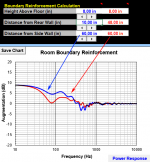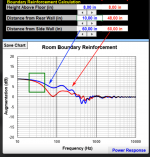sorry, one more correction (and edit time over): the distance to the back wall is of course calculated from the driver (front of the box), not the back of the box. therefore comparison between 10 and 48 inches distance from back wall.
also note colours have changed!
also note colours have changed!
Attachments
Yeah, not big of a difference for typical tuning frequencies even with very large box where changing port location from front to back for example, would result tens of inches change in location relative to room boundaries. The lower the tuning frequency and smaller the box, less of a difference in this regard where the port is located, given that the speaker location stays the same.
Here in your example, if we thought the graphs shows port output (at listening position) while speaker stays at same position, 32" difference would translate 32" deep box, ~80cm, and swapping port from front to back results such difference, few decibels. There is difference, but the speaker is very big. Could you try for example 15" difference, how much that makes? This would be already quite a big speaker.
Here in your example, if we thought the graphs shows port output (at listening position) while speaker stays at same position, 32" difference would translate 32" deep box, ~80cm, and swapping port from front to back results such difference, few decibels. There is difference, but the speaker is very big. Could you try for example 15" difference, how much that makes? This would be already quite a big speaker.
Attachments
Last edited:
thanks tmuikku for the added information.
I shoud emphasize that the simulations do not refer to position of port but rather positioning of the whole box!
I shoud emphasize that the simulations do not refer to position of port but rather positioning of the whole box!
Yes that is understood. If the speaker is relatively small to wavelength, the port is located essentially about at the same position acoustically as rest of the speaker. If the speaker is very big, then the port can be significantly different position than the woofer in relation to room boundaries to make difference in this regard. This is the reasoning, it doesn't matter where the port is located on the speaker unless the speaker is very big and/or tuning high. Effect of the port to room modes is dictated by speaker location not port location. However, possible mid range leaking out the port, this is unwanted and much more prone to port location, this is the problem if there is any.
Last edited:
Because I have heard that you can get midrange leakagewhy can't it be on the front?
Yes, so simple one has to wonder why it's ever asked considering the size of the WL sound 'bubbles' it's reproducing over its narrow BW: ~344 m_s/pi/HzSimple question I thought
As stated it's ludicrous due to a huge acoustical impedance mismatch between the box, vent.Because I have heard that you can get midrange leakage
That said, a poorly designed vent can generate audible noise from too small a cross sectional area (CSA) and/or open cylinder harmonics due to excessive length.
edit: Oops! Missed Scott's response.
Last edited:
Yeah, but you managed to say what I was attempting to say (complete with the maths) in one line. 😉 I really need to work at making my prose a mite more 'efficient'...
why can't it be on the front?
You obviously can and many systems have them their. Apparently the concern is midrange leakage and port noise. I usually put mine on the back and have done sides on subs. The only application I have had a issue with port noise is in LFE subs running toped out. I have never had an issue for standard boxes. I just don't push them that hard and tend to use larger drivers where you typically just don't have large volume port flow.
Rob 🙂
Midrange leakage? Many put too little damping inside their box because they've heard it can reduce the reflex action.
Yes, assuming the flow velocity is going to be reasonably low for your maximum probable LF dynamic peaks, and it's short enough not to have any audible 1/2 wave modes.
Well I don't think I will get port noise through high velocity but the port is 280mm long with a bend in it.Yes, assuming the flow velocity is going to be reasonably low for your maximum probable LF dynamic peaks, and it's short enough not to have any audible 1/2 wave modes.
That's almost double the maximum length I'd be willing to use for a regular speaker; assuming an untapered duct the pipe 1/2 wave fundamental is going to be lurking somewhere around 600Hz (with a bit of leeway for end-correction, local temperature, humidity etc.).
Granted, we're dealing with a matter that is to a point circumstance dependent, and it's a purely arbitrary & somewhat conservative figure on my part, but as noted I normally set a limit of about 6in axial length for an untapered duct, which ensures the pipe's 1/2 wave mode will be >1KHz. As a broad observation, the higher in frequency the pipe fundamental is, the less likely it is to cause issues. YMMV as always of course, and that's just me -I've no doubt that Allen for e.g. will shortly post a strong rebuttal. Ultimately, it all comes down to picking the compromises you can live with.
Granted, we're dealing with a matter that is to a point circumstance dependent, and it's a purely arbitrary & somewhat conservative figure on my part, but as noted I normally set a limit of about 6in axial length for an untapered duct, which ensures the pipe's 1/2 wave mode will be >1KHz. As a broad observation, the higher in frequency the pipe fundamental is, the less likely it is to cause issues. YMMV as always of course, and that's just me -I've no doubt that Allen for e.g. will shortly post a strong rebuttal. Ultimately, it all comes down to picking the compromises you can live with.
Well, you know the answer to that, and since it is of zero practical relevance to the matter in hand, by a process of logical deduction we conclude your objective in writing said is not the seeking or dissemination of information.
Lest there be any confusion on this point, my remark above was a good-humoured observation that you rarely seem to miss an opportunity of looking for something to disagree with in one of my posts -whether it exists or not. 😉
Lest there be any confusion on this point, my remark above was a good-humoured observation that you rarely seem to miss an opportunity of looking for something to disagree with in one of my posts -whether it exists or not. 😉
You give me too much credit, Scott. 🙂 I don't know the answer.
It would go a long way to answering colmo's question. If it takes 600Hz energy from the back of the cone to set the pipe resonance then all you have to do is stuff the box better and the resonance no longer happens.
However, there may be other places that energy could come from.
It would go a long way to answering colmo's question. If it takes 600Hz energy from the back of the cone to set the pipe resonance then all you have to do is stuff the box better and the resonance no longer happens.
However, there may be other places that energy could come from.
From where does a port draw the energy for the pipe resonance?
Air flow just like a pipe organ. How does any wind instrument get their energy??
Rob
- Home
- Loudspeakers
- Multi-Way
- Port Placement

